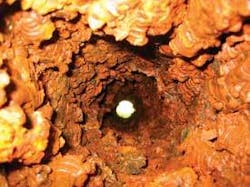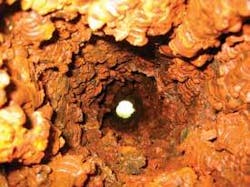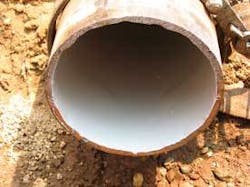Dirty brown water and poor water flow were the first clues that a mid-Atlantic commercial property owner had a problem. Then the owner was put on notice by the local fire department that water supply lines on his property were no longer meeting the minimum flow requirements. Four hydrants on the owner’s property were flowing between 200 to 300 gallons per minute - well below the 1,000 gpm required by code. An inspection revealed the pipes were almost completely clogged with corrosion induced tuberculation.
The first option considered was traditional dig and replace. But the property enjoyed extensive, mature landscaping that the owner strongly wished to avoid damaging. The owner was very concerned about coordinating with other utilities, disrupting tenants and customers, and insuring that future corrosion was prevented. Other critical factors in selecting the most suitable technology for the project included finding a solution that would provide long-term improved water quality and supply - at an affordable price.
The owner called his commercial plumbing contractor, CuraFlo Mid-Atlantic, to see if there was an alternative to digging up and replacing the existing piping. The company was experienced at lining ½" to 4" pipes inside buildings with CuraFlo’s proprietary Engineered Flow Lining System. However, to avoid digging up the larger underground pipes and destroying the extensive landscaping, the 6"and 8" water main pipes would require a trenchless pipe rehabilitation technology that could handle tough access on sensitive grounds as well as avoid digging up numerous connections.
CuraFlo’s proprietary Spincast System was selected. The system is designed for non-structural and semi-structural rehabilitation of 4" to 36" water mains. The process applies a potable-water-certified epoxy to rehabilitate deteriorated, leaky and corrosion clogged pipes. At the AWWA standard 1 mm lining thickness, most typical pinhole leaks are sealed, pressure and flow ratings restored and the prevention of future corrosion is ensured. Thicker applications can be structurally enhancing and seal leaks up to 1/8" in diameter.
In a typical restoration project, pipes are located, isolated and accessed. Access points are typically made at fittings (valves, tees, hydrants, bends, etc.) in conformance with applicable authorities including the local fire department. Pipes are then cleaned using one or more cleaning methods to eliminate debris and corrosion buildup. A post cleaning CCTV inspection is then conducted to check for appropriate cleanliness, water leaks back into the pipe, excessive service protrusions or other issues.
Once cleared for lining, the epoxy lining hose and spray head are inserted and pulled to an exit pit at the far end of the isolated section of pipe where the spray head is attached. The pre-calibrated spray rig is engaged and the hose is extracted at the rate calibrated to the size of the pipe and thickness of the lining. The spray head uses centrifugal force to spin or cast (“spincast”) the lining in a uniform 3600 pattern onto the inside surface of the metal or cement pipes - creating a seamless and protective barrier. The system eliminates corrosion, prevents its reoccurrence, and restores water quality and flow to optimal levels. A post lining CCTV inspection ensures the application was done in accordance with requirements.
During the mid-Atlantic project, over 1,200 linear feet of 6" and 8" cast iron mains were cleaned, lined and inspected in less than two weeks with no disruption in service to the owners’ customers and only minor, temporary property impact.
The results were full restoration of all potable water and hydrant supply pipes on the property. Water flow was restored and all four fire hydrants now supply water at rates equal to or above code requirements of 1,000 gpm.





